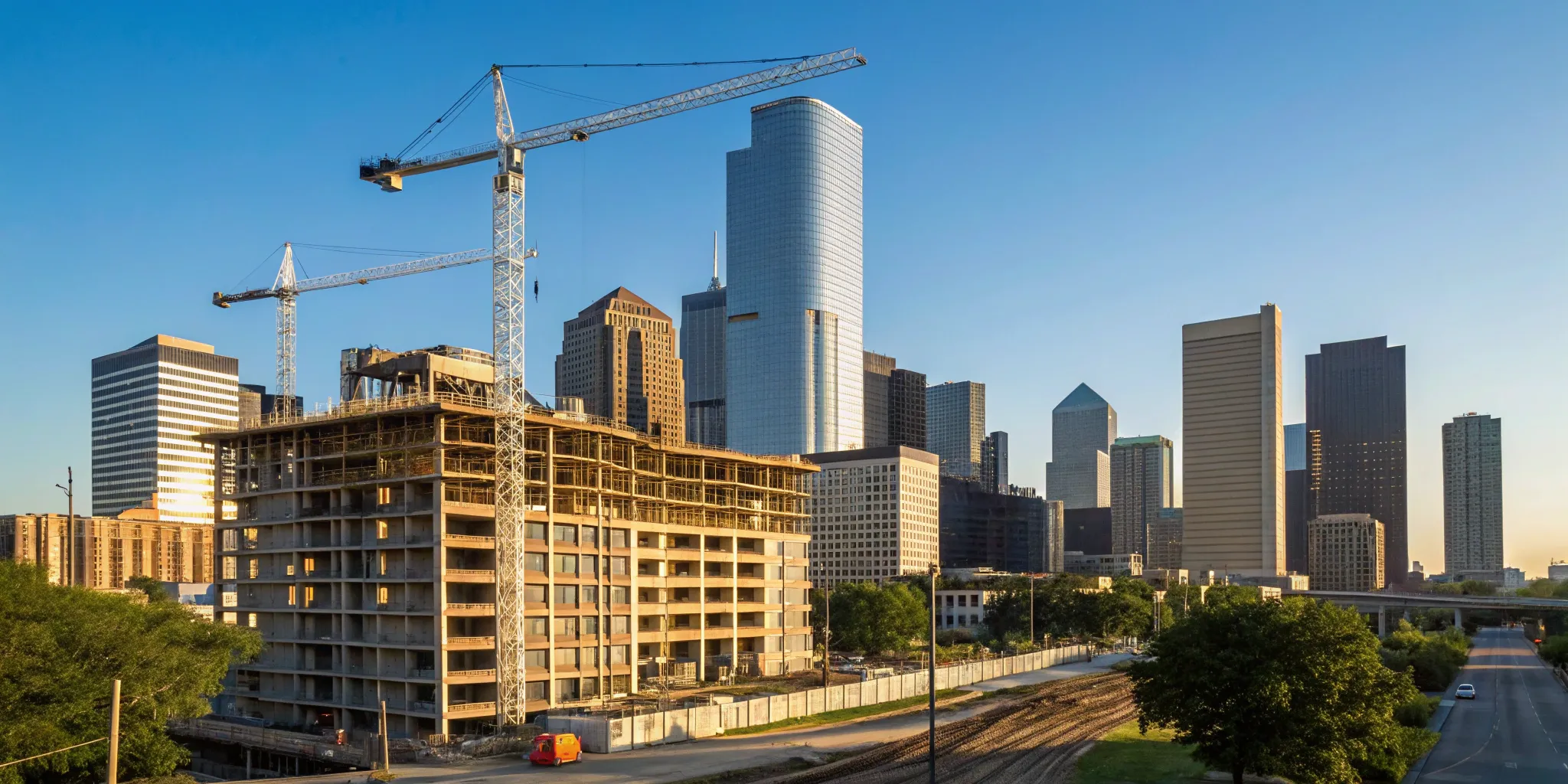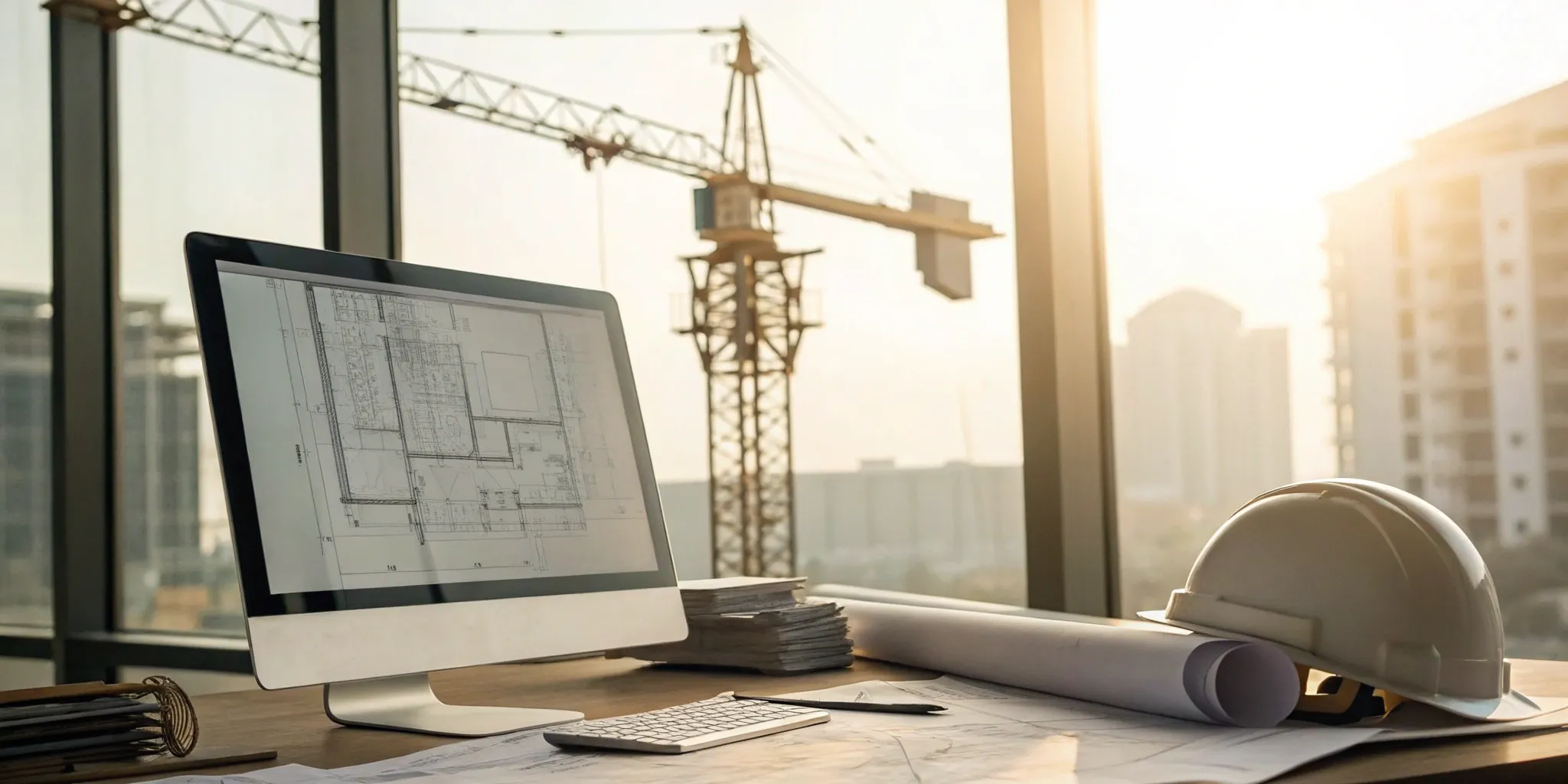
A GC's Guide to Commercial Construction Permits
If you’re a general contractor in Texas, you know that competition is fierce. The key to winning more work is getting in front of opportunities before everyone else does. While your competitors are waiting for projects to hit the open market, you could be tracking the earliest indicator of new construction: permit applications. The world of commercial construction permits is a rich source of project intelligence. By understanding this process, you not only learn how to get your own projects approved faster but also how to spot upcoming work months in advance. This guide explains the permitting system from both sides—as a requirement to fulfill and as a business development tool to leverage.
Key Takeaways
- Master the details before you submit: Your application is your project's first impression. Avoid simple mistakes that cause major delays by double-checking all documents for accuracy, confirming compliance with local codes, and scheduling a pre-application meeting to get ahead of potential issues.
- Use permit data as a strategic advantage: Don't just see permits as a hurdle; see them as an opportunity. Tracking permit applications gives you a direct line of sight into upcoming projects, allowing you to connect with key players and position your team months before the job becomes public knowledge.
- Anticipate delays to protect your timeline: The permitting process rarely goes exactly as planned. Protect your project schedule and budget by building in a generous time buffer from the start, maintaining open communication with reviewers, and allocating resources for potential revisions.
What Are Commercial Construction Permits?
Think of a commercial building permit as the official green light for your project. It’s a legal document from a government agency that authorizes you to start a new construction project or make significant alterations to an existing commercial building. Without it, you can't break ground. But it’s much more than a piece of paper; it’s the outcome of a process designed to ensure your project is safe for the public, complies with local zoning laws, and meets all relevant building codes.
For general contractors, the permitting stage is one of the first major hurdles to clear. It can be complex and time-consuming, but it’s non-negotiable. Understanding this process isn't just about compliance—it's about strategy. The data tied to permit applications offers a clear view of upcoming work in your area, giving you a chance to get ahead of the competition. By tracking permits as they’re filed, you can spot opportunities months before they become common knowledge, which is exactly what our Free Permits App helps you do.
Why Permits Are More Than Just Paperwork
If you’ve ever felt that the permitting process is a bureaucratic maze, you’re not alone. It’s often tangled in local politics, legal challenges, and administrative delays, especially in busy urban areas. Securing a permit isn’t just about filling out a form correctly; it’s about successfully managing a web of requirements.
You’re dealing with complex zoning laws that dictate land use, ever-evolving building codes, and environmental regulations. Each of these elements adds another layer of complexity and potential for delays. This is why getting early visibility into a project is so critical. When you can see a project in its infancy—at the permit application stage—you have more time to understand its specific challenges and position your team as the perfect partner to solve them.
Clearing Up Common Permit Myths
Let’s clear the air on a few common misconceptions about the permitting process. One of the biggest myths is that an issued permit is a guarantee of quality from the city inspector. In reality, a permit is simply permission to start construction. It confirms your plans meet the minimum code requirements on paper, but the responsibility for quality construction and safety on the job site rests entirely with you, the general contractor.
Another myth is that you can just hand over the paperwork and wait for an approval. While that sounds nice, applications are often complex. This is why many GCs work with permit expediters. These professionals aren't just messengers; they are specialists who streamline the process, ensuring your documents are correct and complete before submission, which can save you from costly revisions and delays.
Know the Different Types of Permits
It’s a mistake to think all construction permits are the same. The specific permits you need will depend entirely on the scope and nature of your project. A simple interior renovation won’t require the same level of documentation as a ground-up high-rise.
Most projects start with a general building permit, which covers the primary structure. From there, you’ll likely need several trade-specific permits. These can include electrical permits for wiring and power systems, plumbing permits for pipes and fixtures, and mechanical permits for HVAC systems. If you’re tearing down an existing structure, you’ll also need a demolition permit. Understanding the full scope of work upfront helps you identify every permit you’ll need, preventing unexpected stops down the line.
A Quick Look at Building Codes and Zoning
Navigating building codes and zoning ordinances is a huge part of the permit puzzle. These two sets of rules govern what you can build and how you can build it, and they vary significantly from one city to the next. What’s standard practice in Houston might not meet the requirements in San Antonio.
Here’s a simple breakdown:
- Zoning ordinances define what you can build on a piece of land and for what purpose (e.g., commercial, industrial, or residential). They also cover things like building height, setbacks from property lines, and parking requirements.
- Building codes dictate how you must construct the building. These are technical standards focused on safety and structural integrity, from the type of materials you can use to fire safety protocols. Staying current with the latest International Building Code (IBC) and local amendments is essential for a smooth approval process.
How to Apply for a Permit, Step-by-Step
Getting a permit doesn't have to be a painful process. When you break it down into clear, manageable stages, you can stay organized and keep your project moving forward. Think of it as a four-step roadmap: plan, prepare your documents, submit, and inspect. Following this structure will help you anticipate what's next and reduce the chances of hitting a surprise roadblock that could cost you time and money. Let's walk through each step.
Step 1: Plan Before You Apply
Before you even think about filling out an application, your first move is to create a solid plan. This is where you do your homework on the specific requirements for your project's location and scope. Understanding the common challenges and key considerations from the start can help you manage the complexities and set your project up for success. Schedule a pre-application meeting with the local permitting office. This gives you a chance to discuss your project, ask questions, and get direct feedback from the people who will be reviewing your plans. This simple step can save you from making costly assumptions and prevent major revisions down the line.
Step 2: Gather Your Documents and Plans
With your initial plan in place, it’s time to assemble your application package. This is more than just filling out a form; it’s about providing a complete and accurate picture of your project. You’ll need detailed site plans, architectural drawings, structural engineering calculations, and MEP (mechanical, electrical, and plumbing) schematics. Remember, the commercial building permit is the legal authorization for your project, so every detail matters. Your project will need to meet both local and international building codes, so double-check that all your plans are compliant before you submit them. A thorough, well-organized package shows professionalism and makes the reviewer's job easier, which can only help your case.
Step 3: Submit Your Application and Wait for Review
Once your documents are in order, you can submit your application. Most municipalities now have online portals for digital submissions, which can streamline the process. After you submit, the review period begins. This is often the most frustrating part because it can feel like a waiting game. The permitting process can vary depending on the type and scale of your project, and delays are common. Bureaucratic inefficiencies, complex zoning laws, and evolving building codes can all contribute to a longer wait time. This is a great time to use a tool like Mercator.ai's Free Permits App to monitor other permit activity in your area, helping you spot trends and stay informed while you wait.
Step 4: Prepare for Inspections and Final Approval
After your permit is issued, you can begin construction, but the process isn’t over. You’ll need to schedule a series of inspections at key milestones of the project—like foundation, framing, and final. The inspector’s job is to verify that the work on-site matches the approved plans and meets all safety and quality standards. To make this stage go smoothly, consider engaging a registered building surveyor early in the process to help you identify compliance requirements before you even break ground. Passing these inspections is the final step to getting your certificate of occupancy and officially completing the project.
What You Need for a Successful Application
Submitting a permit application isn't just about filling out a form; it's about presenting a complete, professional, and compliant project package. Think of it as your project's first impression on the city. A sloppy or incomplete application is a surefire way to end up at the bottom of the review pile. Getting everything in order before you submit is the single best thing you can do to avoid frustrating delays. Let’s walk through the key areas you need to nail for a successful application.
Get Your Site Plans and Technical Docs Right
Your site plans and technical documents are the heart of your application. They need to be precise, detailed, and, most importantly, compliant. Every project must meet both local and international building codes, and any deviation will bring the review process to a halt. This means your architectural drawings, structural plans, and MEP (mechanical, electrical, and plumbing) schematics must be flawless. To ensure everything is up to snuff, it’s wise to engage a registered building surveyor or another qualified professional early in the design phase. They can help you spot compliance issues before they become major problems, saving you from costly revisions and the headache of resubmission down the road.
Complete Your Environmental and Safety Checks
Permitting isn't just about the building itself; it's also about its impact on the surrounding area and the safety of everyone involved. You'll likely need to provide environmental assessments, such as soil reports and drainage plans, which are heavily scrutinized in dense urban areas. On the safety side, you’ll need a comprehensive plan that meets OSHA standards and addresses site-specific hazards. Using digital tools can help streamline construction safety permits by automating workflows and keeping all stakeholders in the loop. Proactively addressing these requirements shows the permitting office you’re a responsible builder committed to a safe and sustainable project.
Line Up Your Insurance and Financials
Before a municipality gives you the green light, they want to know you have the resources to see the project through to completion. This means having your financial and insurance documents in order is non-negotiable. Be prepared to show proof of project funding, general liability insurance, and workers' compensation coverage. Tight budgets are one of the biggest challenges in commercial construction, and unexpected costs can derail a project quickly. Having solid financials and adequate insurance coverage not only satisfies the city’s requirements but also protects your business from unforeseen risks. It demonstrates stability and professionalism, building trust with officials and partners alike.
Follow Digital Submission Rules
Most municipalities have moved their permitting processes online, and each has its own set of digital submission rules. This shift to electronic plan submittal means you need to pay close attention to the details. A simple mistake like an incorrect file name or the wrong PDF format can get your application rejected automatically, sending you right back to the start of the queue. Before you upload anything, carefully read the instructions on the city’s permitting portal. Create a checklist for their specific requirements: file types, naming conventions, resolution standards, and required digital signatures. It might feel tedious, but meticulously following these digital rules is a simple way to prevent unnecessary delays and keep your project moving forward.
How to Handle Common Permit Roadblocks
Even the most carefully planned project can hit a snag during the permitting phase. Roadblocks are common, but they don’t have to derail your entire project. The key is to anticipate potential issues and have a strategy ready. By staying organized, managing your timeline, communicating effectively, and planning your resources, you can handle these challenges without breaking a sweat. Let’s walk through some of the most frequent hurdles and how you can clear them.
Solving Documentation and Compliance Headaches
One of the biggest challenges is simply keeping up with the paperwork. With zoning ordinances and building codes varying between cities and counties, compliance can feel like a moving target. Your project has to meet a complex web of local and state requirements. The best way to manage this is to create a master checklist for every project. Before you even think about submitting, confirm the specific requirements for that jurisdiction. Double-check that every drawing is signed and sealed, every form is filled out completely, and you have all the necessary supporting documents. A single missing signature can send you right back to the starting line.
Keep Your Project Timeline on Track
The permitting process can take months, and unexpected delays are the rule, not the exception. Bureaucratic backlogs, requests for more information, and multiple review cycles can all add significant time to your schedule. The most effective strategy is to build a generous buffer into your project timeline from day one. Don't assume a smooth, best-case scenario. By using a tool like the Mercator.ai Free Permits App to spot projects early, you gain valuable lead time. This upstream visibility allows you to start the permitting process sooner, giving you the cushion you need to absorb delays without impacting your construction start date.
Communicate Clearly with Officials
Don't be afraid to talk to the people reviewing your application. Many permit offices are willing to hold pre-application meetings to review requirements and answer your questions. This is your chance to get ahead of potential issues. Come prepared with specific questions about your project to show you’ve done your homework. Building a positive, professional relationship with the plan reviewers and inspectors can make a huge difference. When they know you’re proactive and responsive, the entire process tends to run more smoothly. Clear, consistent communication is one of your most powerful tools.
Plan Your Budget and Resources
Permitting isn't free, and the costs can be more than just the initial application fee. You need to budget for potential revisions to your plans, consultant fees, and even re-submission fees if your initial application is rejected. Commercial construction projects are complex, and your budget should reflect that. Make sure you have a clear line item for all permitting-related expenses. It’s also wise to assign a dedicated person or team to manage the process. Having a point person who owns the application from start to finish ensures accountability and prevents things from falling through the cracks.
Related Articles
- A Guide to Commercial Construction Contractors
- Commercial Construction Texas: The Ultimate Guide
- Building Permit Data: A Complete Guide for 2025
Frequently Asked Questions
Is it really worth the cost to hire a permit expediter? For a simple project, you might be able to handle the permit process yourself. But for larger, more complex commercial jobs, a good permit expediter is often a smart investment. Think of them less as a messenger and more as a specialist who knows the local system inside and out. They can spot potential issues with your application before you even submit it, saving you from the costly delays that come with revisions and resubmissions. It's about weighing their fee against the cost of your project sitting idle for weeks or even months.
What's the single biggest mistake contractors make when applying for permits? The most common and costly mistake is submitting an incomplete or inaccurate application. It’s easy to get focused on the big picture and rush through the paperwork, but a single missing signature, an incorrect form, or a non-compliant drawing can get your entire package rejected. This sends you right to the back of the review queue. The best thing you can do is slow down and be meticulous. Create a checklist based on the city’s specific requirements and double-check every single item before you hit submit.
What happens if I need to change my plans after the permit has already been issued? Changes happen, and permitting offices have a process for it. You can't just alter the work on-site and hope no one notices. You'll typically need to submit a permit amendment or revision, which includes the updated plans and a description of the changes. This revised plan will go through its own review and approval process. It’s critical to get this official approval before you proceed with the new work, otherwise you risk failing inspections and facing penalties.
Realistically, how long should I expect the permit review process to take? There isn't a one-size-fits-all answer, as the timeline depends entirely on your project's complexity and the city's current workload. A straightforward interior renovation might take a few weeks, while a new ground-up building could easily take several months. Your best bet is to ask for an estimated timeline during a pre-application meeting with the permit office. Whatever estimate they give you, it's always wise to build a generous buffer into your project schedule to account for unexpected delays.
Besides the application fee, what other hidden costs should I budget for? The application fee is just the beginning. You should also plan for several other potential expenses to avoid surprises. These can include fees for plan revisions if the city requests changes, consultant fees for engineers or surveyors, and potential impact fees that municipalities charge to cover the project's effect on public infrastructure. If your application is rejected, you may also have to pay a re-submission fee. Factoring these possibilities into your budget from the start will protect your bottom line.
AI-powered business development for the construction industry
Schedule a time to discuss your use case and walk through a custom demo of the platform.


